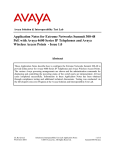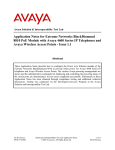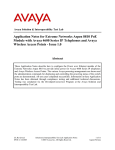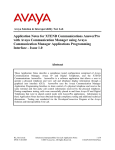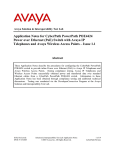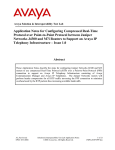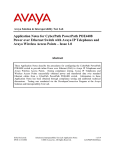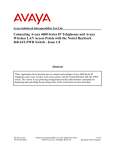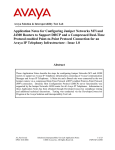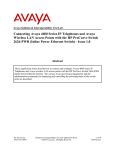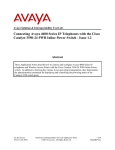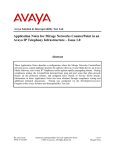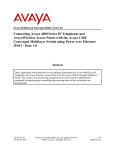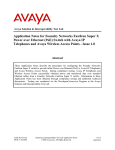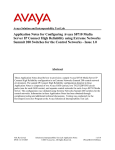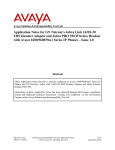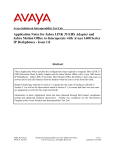Download Avaya 4600 Series IP Telephones Application Note
Transcript
Avaya Solution & Interoperability Test Lab Application Notes for Extreme Networks Alpine 3808 Power over Ethernet (PoE) with Avaya 4600 Series IP Telephones and Avaya Wireless Access Points – Issue 1.0 Abstract These Application Notes describe the procedures for configuring the Extreme Networks Alpine 3808 to provide inline Power over Ethernet (PoE) to Avaya 4600 Series IP Telephones and Avaya Wireless Access Points. During compliance testing, Avaya IP Telephones and Wireless Access Points successfully obtained power and transferred data over standard Ethernet cables from an Alpine 3808 equipped with an Alpine FM-32Pi PoE Module. Information in these Application Notes has been obtained through compliance testing and additional technical discussions. Testing was conducted via the DeveloperConnection Program at the Avaya Solution and Interoperability Test Lab. RL; Reviewed: WCH 10/22/2004 Solution & Interoperability Test Lab Application Notes ©2004 Avaya Inc. All Rights Reserved. 1 of 10 Alpine3808-PoE.doc 1. Introduction Power over Ethernet (PoE) allows both power and data to be simultaneously carried over standard Ethernet cables. PoE-enabled Ethernet switches can supply power directly to Ethernet devices, thereby simplifying installation and removing the need for separate power supplies for those devices. The IEEE 802.3af standard defines the mechanisms for Power Sourcing Equipment (PSE), such as PoE-enabled Ethernet switches, to detect, classify, and supply power to Powered Devices (PDs), such as PoE-enabled IP telephones and wireless access points. In the compliance-tested configuration described in these Application Notes, an Extreme Networks Alpine 3808 equipped with a 32-port Alpine FM-32Pi PoE Module is a PSE configured to supply inline PoE to Avaya PDs, specifically Avaya 4600 Series IP Telephones and Avaya AP4/5/6 Wireless Access Points. As illustrated in Figure 1, the Avaya PDs covered in these Application Notes include the following: • • • • • • • • • • • • 4602 IP Telephone 4602SW IP Telephone 4610SW IP Telephone 4620 IP Telephone with and without EU24 expansion module 4620SW IP Telephone with and without EU24 expansion module 4630SW IP Telephone “Generation 1” 4612 IP Telephone with 30A Switch Base “Generation 1” 4624 IP Telephone with 30A Switch Base “Generation 2” 4606 IP Telephone “Generation 2” 4612 IP Telephone “Generation 2” 4624 IP Telephone AP-4/5/6 Wireless 802.11a/b/g Access Point The Avaya “Generation 1” and “Generation 2” 4612 and 4624 IP Telephones are distinguishable by their model numbers. For example, the model number “4612D01A – 003” indicates Generation 1, while the model number “4612D02A – 003” indicates Generation 2. The 30A Switch Base shown in Figure 2 is required for the Avaya “Generation 1” 4612 and 4624 IP Telephones to be powered by PoE. RL; Reviewed: WCH 10/22/2004 Solution & Interoperability Test Lab Application Notes ©2004 Avaya Inc. All Rights Reserved. 2 of 10 Alpine3808-PoE.doc Alpine 3808 4602, 4602SW IP Phones AP-4/5/6 Wireless Access Point Generation-2 4606, 4612, 4624 IP Phones 4610SW IP Phone 4620, 4620-EU24, 4620SW, 4620SW-EU24 IP Phones 4630SW IP Phone Generation-1 4612, 4624 IP Phones with 30A Switch Base Figure 1: PoE Interoperability Between Extreme Networks Alpine 3808 with Alpine FM32Pi PoE Module and Avaya 4600 Series IP Telephones and Avaya Wireless Access Points Figure 2: 30A Switch Base for Generation-1 Avaya 4612 and 4624 IP Telephones RL; Reviewed: WCH 10/22/2004 Solution & Interoperability Test Lab Application Notes ©2004 Avaya Inc. All Rights Reserved. 3 of 10 Alpine3808-PoE.doc 2. Equipment and Software Validated The following equipment and software/firmware were used for the sample configuration provided: Equipment Avaya S8500 Media Server running Avaya Communication Manager Avaya G650 Media Gateway TN2312BP IPSI TN799DP C-LAN TN2302AP MedPro Avaya 4602 IP Telephone Avaya 4602SW IP Telephone Avaya 4610SW IP Telephone Avaya 4620 IP Telephone Avaya 4620 IP Telephone with EU24 Avaya 4620SW IP Telephone Avaya 4620SW IP Telephone with EU24 Avaya 4630SW IP Telephone Avaya 4612 IP Telephone (Generation 1) with 30A Avaya 4624 IP Telephone (Generation 1) with 30A Avaya 4606 IP Telephone (Generation 2) Avaya 4612 IP Telephone (Generation 2) Avaya 4624 IP Telephone (Generation 2) Avaya AP-4/5/6 Wireless Access Point Avaya IP Softphone Extreme Networks Alpine 3808 with FM-32Pi PoE Module RL; Reviewed: WCH 10/22/2004 Software/Firmware 2.1 (R012x.01.0.411.7) 9 11 92 1.8.2 1.8.2 2.1 2.1 2.1 2.1 2.1 2.0.1 1.8.2 1.8.2 1.8.2 1.8.2 1.8.2 2.4.5 5.1 ExtremeWare 7.2.0 Build 33 Solution & Interoperability Test Lab Application Notes ©2004 Avaya Inc. All Rights Reserved. 4 of 10 Alpine3808-PoE.doc 3. Configure Inline Power over Ethernet on the Extreme Networks Alpine 3808 Inline Power over Ethernet (PoE) is supported on the Alpine 3808 with addition of the Alpine FM-32Pi PoE Module. By default, PoE support is enabled on the system and on all slots. The following commands can be used to explicitly enable PoE support on both the system and a slot containing an Alpine FM-32Pi PoE Module. enable inline-power enable inline-power slot 5 Each PoE-capable port automatically detects 802.3af-compliant Powered Devices (PDs) and may be configured to also supply power to detected PDs. The following command allows ports 1 through 16 on slot 5 to detect and supply power to PDs. configure inline-power detection auto ports 5:1-5:16 Inline power budgeting in the Alpine 3808 is based on allocated power, not actual power consumption. For example, a detected PD may be allocated 15.4 Watts even though it may actually consume less than that. The Alpine 3808 can be configured to allocate power on a PoEcapable port based on the 802.3af class of the detected PD, the configured maximum power on the port, the greater of the class power and configured maximum power on the port, or the maximum allowed power on the port (20 Watts). The following commands configure the Alpine 3808 to allocate power based on the detected PD’s advertised class for ports 1 through 16 on slot 5, and enable PoE support on those ports (by default, PoE support is enabled on all PoE-capable ports). configure inline-power violation-precedence advertise-class ports 5:1-5:16 enable inline-power ports 5:1-5:16 Alternatively, if the actual power range drawn on a PoE-capable port is known, then the Alpine 3808 may be configured to allocate power based on the actual maximum rather than the 802.3af power class of the detected PD on the port. The following commands set the “operator-limit” on port 17 to 5 Watts and instruct the Alpine 3808 to allocate power based on the operator-limit value on port 17. Note that any PD that draws more than 5 Watts will be denied power if connected to that port. Therefore, the operator-limit should be set to a value that accurately represents the actual power required by PDs expected to connect to that port. configure inline-power operator-limit 5000 ports 5:17 configure inline-power violation-precedence operator-limit ports 5:17 enable inline-power ports 5:17 An external 48V power source provides power to the Alpine FM-32Pi PoE Module. As shown in the following command, the Alpine 3808’s internal power supply may be configured as a RL; Reviewed: WCH 10/22/2004 Solution & Interoperability Test Lab Application Notes ©2004 Avaya Inc. All Rights Reserved. 5 of 10 Alpine3808-PoE.doc backup to the external power source. Note that the internal power supply provides up to 32 Watts to the Alpine FM-32Pi PoE Module. configure inline-power backup-source internal slot 5 Enter the commands show inline-power configuration slot <slotlist> and show inline-power configuration ports <portlist> to verify that PoE support is enabled on a slot and ports on a slot, respectively. Alpine3808:175 # show inline-power configuration slot 5 Slot Status Cfg PSU Backup PSU Active Usage Threshold Watchdog 5 Enabled Internal External 70 % enabled Alpine3808:176 # show inline-power configuration ports 5:1-5:16 Port Config Detect Rsvd Pwr Oper Lmt Viol Prec Label 5:1 enabled auto 0.0 15.4 advertised-class 5:2 enabled auto 0.0 15.4 advertised-class 5:3 enabled auto 0.0 15.4 advertised-class 5:4 enabled auto 0.0 15.4 advertised-class 5:5 enabled auto 0.0 15.4 advertised-class 5:6 enabled auto 0.0 15.4 advertised-class 5:7 enabled auto 0.0 15.4 advertised-class 5:8 enabled auto 0.0 15.4 advertised-class 5:9 enabled auto 0.0 15.4 advertised-class 5:10 enabled auto 0.0 15.4 advertised-class 5:11 enabled auto 0.0 15.4 advertised-class 5:12 enabled auto 0.0 15.4 advertised-class 5:13 enabled auto 0.0 15.4 advertised-class 5:14 enabled auto 0.0 15.4 advertised-class 5:15 enabled auto 0.0 15.4 advertised-class 5:16 enabled auto 0.0 15.4 advertised-class Enter the command show inline-power to view the inline power information for the Alpine 3808 system. Alpine3808:273 # show inline-power Inline Power System Information System maximum inline-power: 334 watts Power Usage: 70% (233 watts) Slot 5 Main PSU Status ON Backup PSU Status Present, DEACTIVATED Firmware Status Operational Enter the command show inline-power slot <slotlist> to view the inline power information for a slot. The output below indicates that 141.2 Watts has been allocated to connected PDs on the slot and the actual total power consumption of those PDs is 57.8 Watts. Alpine3808:274 # show inline-power slot 5 Common Power Reserved Power Slot Configured Allocated Configured Allocated 5 334000mW 141200mW 0 mW 0 mW RL; Reviewed: WCH 10/22/2004 Solution & Interoperability Test Lab Application Notes ©2004 Avaya Inc. All Rights Reserved. Measured usage 57800mW 6 of 10 Alpine3808-PoE.doc Enter the command show inline-power info ports <portlist> to obtain inline power information for one or more ports. The output of the command displays the inline power state, detected 802.3af class, actual power consumption, and fault state on each specified port. Alpine3808:275 # show inline-power info ports 5:1-5:16 Port State Class Connect Volts Curr Res Power History (mA) (Kohms) (Watts) 5:1 delivering class1 1 50.1 62 25.2 3.10 5:2 delivering class2 2 50.1 62 25.2 3.20 5:3 delivering class2 3 49.8 64 24.8 3.20 5:4 delivering class3 4 49.8 138 24.4 6.90 5:5 delivering class3 5 49.8 120 24.0 6.00 5:6 delivering class3 6 49.8 212 24.0 10.60 5:7 delivering class3 7 49.8 106 24.4 5.30 5:8 delivering class0 8 49.8 94 24.8 4.60 5:9 delivering class0 9 49.8 92 24.4 4.60 5:10 delivering class0 10 49.8 98 24.0 4.90 5:11 delivering class0 11 49.8 112 25.2 5.60 5:12 searching -----0 0.0 0 0.0 0.00 5:13 searching -----0 0.0 0 0.0 0.00 5:14 searching -----0 0.0 0 0.0 0.00 5:15 searching -----0 0.0 0 0.0 0.00 5:16 searching -----0 0.0 0 0.0 0.00 Fault None None None None None None None None None None None None None None None None For more detailed inline power information for one or more ports, enter the command show inline-power info detail ports <portlist>. 4. Interoperability Compliance Testing The interoperability compliance testing focused on verifying PoE interoperability between the Extreme Networks Alpine 3808 and Avaya 4600 Series IP Telephones and Avaya AP-4/5/6 Wireless Access Points. 4.1. General Test Approach The general test approach was to connect the Avaya PDs (Avaya 4600 Series IP Telephones and Avaya AP-4/5/6 Wireless Access Points) to PoE-enabled ports on the Alpine FM-32Pi PoE Module and verify that the PDs successfully boot. To test repeatability, PoE was then disabled and enabled again on the connected ports. Lastly, to verify that power and data can be simultaneously carried on the PoE connections, phone calls were made from the IP Telephones and an IP Softphone on a wireless laptop accessing the network via the AP-4/5/6. 4.2. Test Results All test cases completed successfully. The Alpine 3808 equipped with an Alpine FM-32Pi PoE Module successfully provided inline power to the Avaya PDs. Table 1 below lists the 802.3af class, allocated power, and measured power of the Avaya PDs when connected to the Alpine FM-32Pi PoE Module. All of the IP Telephones were in idle/on-hook states. RL; Reviewed: WCH 10/22/2004 Solution & Interoperability Test Lab Application Notes ©2004 Avaya Inc. All Rights Reserved. 7 of 10 Alpine3808-PoE.doc Avaya Powered Device 4602 4602SW 4610SW 4620 4620 with EU24 4620SW 4620SW with EU24 4630SW Gen-1 4612 with 30A Gen-1 4624 with 30A Gen-2 4606 Gen-2 4612 Gen-2 4624 AP-4/5/6 802.3af Class 1 2 2 3 3 3 3 3 3 3 0 0 0 0 Allocated Power (W) 4 7 7 15.4 15.4 15.4 15.4 15.4 15.4 15.4 15.4 15.4 15.4 15.4 Measured Power (W) 3.1 3.2 3.2 6.9 7.6 5.3 6.0 10.6 5.4 5.3 4.6 4.6 4.9 5.6 Table 1: 802.3af Class, Allocated Power, and Measured Power for Avaya 4600 Series IP Telephones and Wireless Access Points connected to Extreme Networks Alpine 3808. Table 2 below summarizes the 802.3af classes. Class 0 1 2 3 4 PSE Output Max. Power (W) 15.4 4.0 7.0 15.4 Treat as Class 0 Table 2: IEEE 802.3af Power Classifications 5. Verification Steps The following steps may be used to verify the configuration: 1. Ensure that PoE has been enabled on the system, the slot housing the Alpine FM-32Pi PoE Module, and the ports that serve the PDs. 2. Connect the Avaya PD to a PoE enabled port on the Alpine FM-32Pi PoE Module and verify that the PD powers on successfully. If the PD does not power on, enter the command show inline-power info detail ports <portlist>. 3. If the output shows that the “Inline Power State” is “discovered”, then disable inlinepower on the port, enter the command configure inline-power detection auto ports <portlist>, and re-enable inline-power on the port. RL; Reviewed: WCH 10/22/2004 Solution & Interoperability Test Lab Application Notes ©2004 Avaya Inc. All Rights Reserved. 8 of 10 Alpine3808-PoE.doc 4. If the output shows that the “Inline Power State” is “denied”, then there is insufficient available power to power the PD. 5. For the Avaya 4600 Series IP Telephone, verify that it successfully registers with Avaya Communication Manager and completes phone calls to other phones (assumes the IP telephone has been configured with the correct IP and call control information). 6. For the Avaya Wireless Access Point, verify that an Avaya IP Softphone running on a wireless laptop accessing the network via the Access Point successfully registers with Avaya Communication Manager and completes phone calls to other phones (assumes the IP softphone has been configured with the correct IP and call control information). 6. Support For technical support on Extreme Networks products, consult the support pages at http:///www.extremenetworks.com/services or contact the Extreme Networks Worldwide TAC at: • Toll free: 800-998-2408 • Phone: 408-579-2826 • E-mail: [email protected] 7. Conclusion These Application Notes describe the steps for configuring the Extreme Networks Alpine 3808 to provide inline Power over Ethernet (PoE) to the Avaya PDs, namely Avaya 4600 Series IP Telephones and Avaya Wireless Access Points. During compliance testing, the Avaya PDs simultaneously obtained power and transferred data over standard Ethernet cables from the Alpine 3808. 8. Additional References Product documentation for Avaya products may be found at http://support.avaya.com. Product documentation for Extreme Networks products may be found at: http://www.extremenetworks.com/services/documentation. RL; Reviewed: WCH 10/22/2004 Solution & Interoperability Test Lab Application Notes ©2004 Avaya Inc. All Rights Reserved. 9 of 10 Alpine3808-PoE.doc ©2004 Avaya Inc. All Rights Reserved. Avaya and the Avaya Logo are trademarks of Avaya Inc. All trademarks identified by ® and ™ are registered trademarks or trademarks, respectively, of Avaya Inc. All other trademarks are the property of their respective owners. The information provided in these Application Notes is subject to change without notice. The configurations, technical data, and recommendations provided in these Application Notes are believed to be accurate and dependable, but are presented without express or implied warranty. Users are responsible for their application of any products specified in these Application Notes. Please e-mail any questions or comments pertaining to these Application Notes along with the full title name and filename, located in the lower right corner, directly to the Avaya DeveloperConnection Program at [email protected]. RL; Reviewed: WCH 10/22/2004 Solution & Interoperability Test Lab Application Notes ©2004 Avaya Inc. All Rights Reserved. 10 of 10 Alpine3808-PoE.doc










